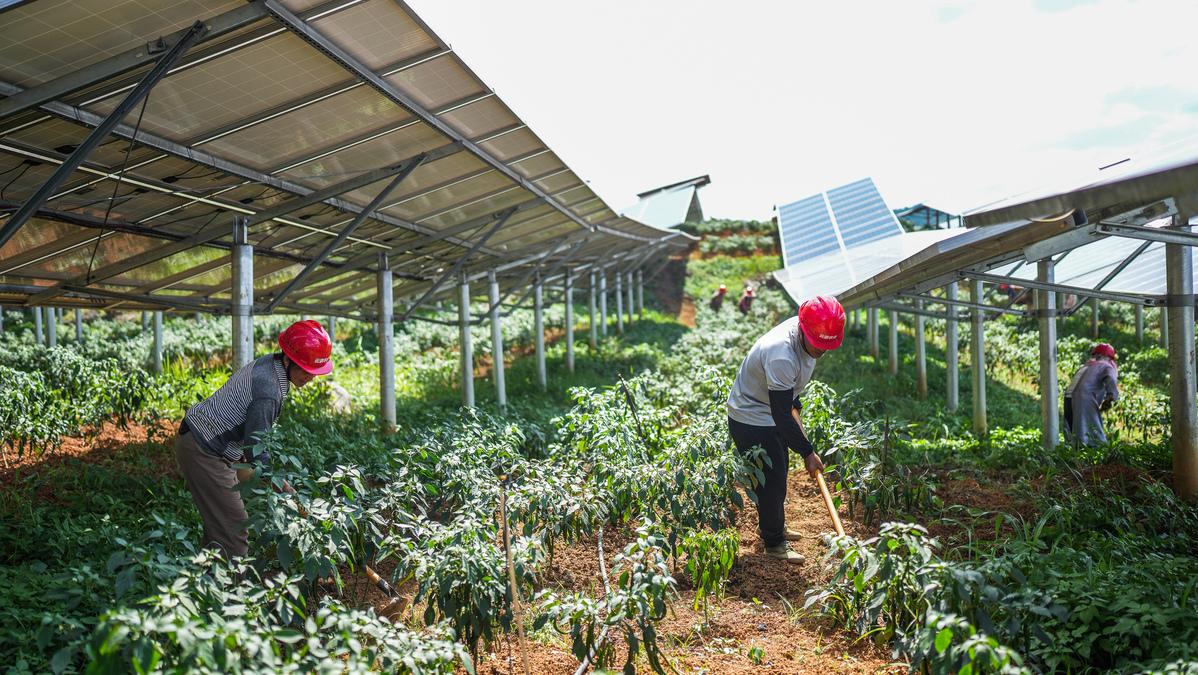 Villagers cultivate red chili plants under solar panels in the Qianxinan Bouyei and Miao autonomous prefecture, Guizhou province, in July. TAO LIANG/XINHUA
Villagers cultivate red chili plants under solar panels in the Qianxinan Bouyei and Miao autonomous prefecture, Guizhou province, in July. TAO LIANG/XINHUARural areas in China are seizing new opportunities brought on by the growth of the photovoltaic sector.
An emerging production model, known as "agrivoltaics" that combines the use of land for food production and PV for electricity generation, is paving the way for multifaceted rural development.
The edible mushroom industry has for long been a poverty alleviator in Gutian county of Ningde, Fujian province.
In recent years, the county has propelled the transformation and upgrading of its edible mushroom industry, with a focus on improving cultivation conditions.
Last year, a transition away from traditional mushroom fruiting rooms to photovoltaic mushroom farms increased yields by about 20 percent, with the price per pack rising by about 1 yuan ($0.14) compared to the previous year due to higher quality, said Yu Xinkao, a local mushroom grower.
"The total income from a single crop of mushrooms is expected to increase by around 80,000 yuan," Yu said.
With advantages including higher production efficiency, concentrated land use and optimized safety control, the mushroom agrivoltaic project has successfully led to a multidimensional development pattern, fostering increased income for mushroom growers and local enterprises while generating power.
Zheng Guidong, deputy Party secretary of Gutian county, said eight photovoltaic mushroom growing bases have been established in the county since May 2021, constructing 450 standardized mushroom production sheds with a total investment of 370 million yuan.
The overall installed capacity of the agrivoltaic project stands at 30.746 megawatts, with an estimated annual output of about 31.74 million kilowatt-hours and an annual power generation revenue of 13.5 million yuan, Zheng said.
Similarly, at an agrivoltaic demonstration area in Xinqiao township, Qianxinan Bouyei and Miao autonomous prefecture in Guizhou province, neatly arranged solar panels cast shadows on rows of red chili plants, and workers are busy harvesting and loading red chilies onto trucks.
He Yu, Party secretary of the Qianxinan subsidiary of SPIC Guizhou Jinyuan Co Ltd, the operator of the agrivoltaic demonstration project, said the new energy company has — through cooperation with local agricultural firms — adapted to local conditions and cultivated economic crops such as taros, pumpkins, chilis, prickly pears, tobacco, Chinese cabbages and Chinese toon under the solar panels.
"The planting area has reached over 2,000 mu (133.3 hectares), with a total output of 750,000 kilograms and a production value of nearly 2 million yuan. It has also helped increase local farmers' incomes by about 500,000 yuan," He said.
The company will continue to promote its agrivoltaic industry while keeping up with the development trends and policies of the new energy sector, He added.
"We will continue to expand the scale of agrivoltaic projects, create more job opportunities, and eventually push forward the process of rural revitalization."
With a total rooftop area of around 27.3 billion square meters and over 80 million rural households capable of photovoltaic installation, China's rural areas have demonstrated huge potential for agrivoltaic development, said the National Energy Administration.
Integrating clean energy technology and rural revitalization can help create a powerful engine for the smart and green development of rural areas, said Yang Yongping, president of the North China Electric Power University, during a forum.
"The vast rural areas possess abundant biological resources, power supply and profit potential. We should tailor our efforts to local conditions and vigorously promote the development of new energy sources," Yang said.
Currently, the cumulative number of rural households installed with distributed photovoltaics has exceeded 5 million, driving investment of over 500 billion yuan, data from the NEA showed.
As of end-September, the cumulative installed capacity of distributed photovoltaics nationwide had exceeded the 100 million kW threshold to reach 105 million kW.
This has taken the nation's total installed capacity of photovoltaic power generation to 520 million kW, according to the NEA.
Category
'Agrivoltaics' Lights up Rural Revitalization Efforts
Contributor
'Agrivoltaics' Lights up Rural Revitalization Efforts
Country
Technical Solution

